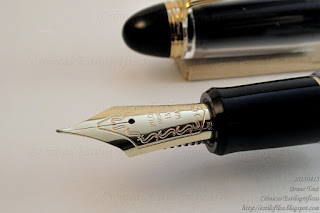Sailor pen nibs have consistently been engraved with a three digit code in the form
abb.
On it, bb –from 01 to 12— stands for the month, and a –from 0 to 9— is the last digit of the year of production.

This nib is dated on 710--October of some year ending in 7. And later than 1954, when the JIS stamp was engraved on pen nibs. It belongs to the following pen.

A bulb-filler previous to the time of cartridges and converters. Most likely, therefore, made in 1957.
Needless to say, this system is not so precise as those seen on Pilot (::1::, ::2::) and Platinum pens. Sailor, so to speak, demands some additional knowledge on the pen model in order to decide whether that 3 (for a) meant 2013 or 2003 or, even, 1993.

This Ohashido nib, by Sailor, was made on November of 2014. The nib was not yet attached to any pen. The picture was taken during the last Fountain Pens of the World Fair at Mitsukoshi Nihonbashi.
Ohashido nibs, currently made by Sailor, also display this dating code. However, not all Sailor nibs are dated—just most of them.
Pelikan 400 NN M&K – Nagasawa Bokkô
Bruno Taut
Shinjuku, June 20th, 2015
etiquetas: Sailor, Platinum, Ohashido, Pilot, plumín
Bruno Taut
Shinjuku, June 20th, 2015
etiquetas: Sailor, Platinum, Ohashido, Pilot, plumín











































